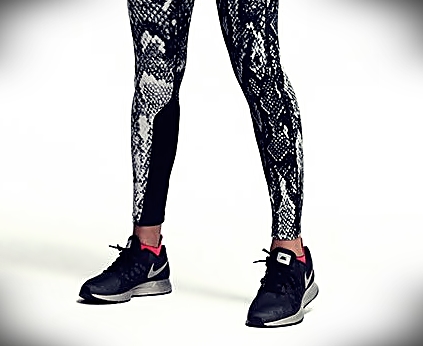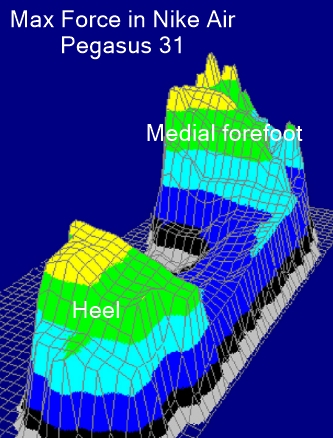The Nike Air Pegasus 31 running shoe is not the best choice for forefoot running. A study by Wiegerinck et al., (2009) reported that runners who ran in the Nike Air Pegasus 31 had a higher maximum force in the medial forefoot as compared with runners who ran in racing flats.
The problem with a higher maximum force in the medial forefoot is that the big toe and second toe bears more loading than the more lateral toes, which researchers have pinpointed as a risk factor for forefoot pain as well as metatarsal stress fracture (Nega et al., 2008; Tam et al. 2014; Keijsers et al., 2013).


The researchers speculated that the arch support in the Nike Air Pegasus 31 led to higher rates of maximum force in the medial forefoot during running. Yet this finding is not surprising. Cushioned running shoes, like the Nike Air Pegasus 31, is typically associated with states of high peak pressures on the foot. Other researchers caution that runners with high peak pressures in the medial forefoot need adequate adaptation time to allow bone remodelling (Kasmer et al., 2014).
Pegasus 31 May Elicit Bad Landing Behavior
Although the current study did not consider foot strike, the structural components of the Nike Air Pegasus 31 facilitates heel strike or an improper forefoot strike during running. These structures include a thickly cushioned heel as well as greater outsole thickness compared to racing flats.
In addition, the midsole of the Pegasus 31 contains pressurized air bladders encapsulated in foam at the heel and forefoot. The outsole also contains a sticky rubber material on the forefoot. All this protection hides stimulation areas of the plantar surface and results in a foot strike pattern that necessitates higher peak pressures on areas of the foot that are not intended for weight-bearing when barefoot.
The Take Home Message
When considering a shoe for forefoot running, avoid shoes such as the Nike Air Pegasus 31, especially if you are new to forefoot running.
Since a relationship between sensory input and plantar pressure distribution exists, wear barefoot-like running shoes to enhance perception of foot strike or run barefoot which has led to the widespread assumption that it leads to marked increases in natural foot motions as well as footfall control.
More From Run Forefoot:
- Forefoot Running
- Heel Strike Running
- Forefoot Running Shoe Reviews
- Why Avoid Standard Running Shoes
- Pros to Going Barefoot
References:
Chen et al. Influence of sensory input on plantar pressure distribution. Clin Bio, 1995; 10(5):271-74.
Kasmer ME., Ketchum NC and Liu XC. The effect of shoe type on gait in forefoot strike runners during a 50-km run. J Sport Health Sci, 2014;3:122-130
Keijsers, N. L., Stolwijk, N. M., Louwerens, J. W., & Duysens, J. (2013). Classification of forefoot pain based on plantar pressure measurements. Clinical Biomechanics (Bristol, Avon), 28, 350–356.
Nagel, A., Fernholz, F., Kibele, C., & Rosenbaum, D. (2008). Long distance running increases plantar pressures beneath the metatarsal heads: a barefoot walking investigation of 200 marathon runners. Gait & Posture, 27, 152–155.
Tam, N., Wilson, J. L. A., Noakes, T. D., & Tucker, R. (2014). Barefoot running: an evaluation of current hypothesis future research and clinical applications. British Journal of Sports Medicine, 48, 349–355.
Wiegerinck et al. Differences in plantar loading between training shoes and racing flats at a self-selected running speed. Gait & Posture, 2009;29:514-519.
Bretta Riches
BSc Neurobiology; MSc Biomechanics candidate, ultra minimalist runner & founder of RunForefoot. I was a heel striker, always injured. I was inspired by the great Tirunesh Dibaba to try forefoot running. Now, I'm injury free. This is why I launched Run Forefoot, to advocate the health & performance benefits of forefoot running and to raise awareness on the dangers of heel striking, because the world needs to know.
Latest posts by Bretta Riches (see all)
- How to Train Yourself to Not Heel Strike When Running - 24/04/2024
- Cushioned Running Shoes Found to Be Bad for Ankles - 23/04/2024
- Forefoot Running and Achilles Pain - 19/04/2024

Leave a Reply